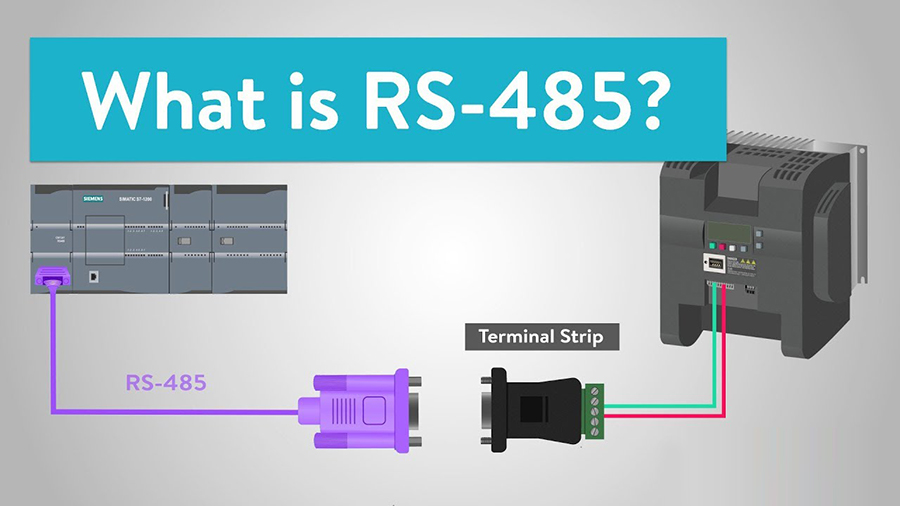While Ethernet is the most commonly used communication protocol in a wide variety of devices, from consumer gadgets to industrial equipment, TIA/EIA RS485, commonly known as RS485, is still widely used in industrial equipment, even if it predates Ethernet. Let's see why it's still in use, and why, among connected devices, we decided to use it as the standard communication protocol for our devices.
Many people are often confused when dealing with communication standards. In general, terms such as "RS485," "USB," and "Ethernet" are interchangeable as if they were interchangeable and did the same job. But in fact, RS485 standard is only a physical layer standard. It defines the electrical characteristics of the transmitter and receiver.Most importantly, the application layer must be used to handle device addresses, checksums, packet collisions, master/slave topology, frame structures, and so on. In the case of Ethernet and USB, these protocols define the physical and application layers in their communication standards.
If the human voice is used as a transmitter, the ear is used as a receiver. This is our physical layer, the way we transmit information. Another example of the physical layer in our digital age can also be the SMS that transmits our information. From our point of view, it is still a physical layer. As far as humans are concerned, the application layer is language. This is how we organize information. There are hundreds of them, and even if they use the same physical layer, they are not necessarily compatible.
What is RS485 and RS485 networking Mode

Ethernet (IEEE 802.3) is the most widely used network protocol today. It is also a serial communication standard. Since it is used in many modern networks, the question is why it has not replaced RS485 and its other variants (RS232, RS422).
When comparing RS485 and Ethernet, RS485 is designed to be used in a master/slave topology. In this system, the master polls each slave, waits for a response, and then polls the next slave. This allows deterministic behavior by avoiding collisions of packets. However, Ethernet has no built-in way to avoid packet collisions. In applications such as process control or robot control, deterministic behavior is mandatory for us, and the communication speed is usually high enough.Communicating at lower speeds also has the advantage of being more resilient to noise present in industrial environments.
The RS485 is capable of supporting up to 32 drivers and up to 32 receivers in a half-duplex multidrop configuration. The receiver input sensitivity is ± 200mV, which means that to recognize a 1 or 0 bit, the receiver must see a signal level between + 200 mV and -200 mV. The minimum receiver input impedance is 12 kΩ, and the driver output voltage is ± 1.5 V minimum and ± 5 V maximum. This is an example of a multidrop RS-485 bus.
RS485 can transmit up to 1200 m (4000 feet) at data rates below 100 K bps. At higher data rates, the cable length must be reduced.
Long cables can act as transmission lines, in which case care should be taken to properly connect the network.
Network topology determines how devices are connected together. Among these possibilities, the best network topology for RS485 is daisy-chain (or wire), because this topology has the least impact on signal integrity. A bus topology (backbone using stubs) is possible, but as the length of each stub increases, the maximum data rate that can be transmitted decreases due to signal distortion on the communication line.
Using twisted-pair for RS485 helps reduce electromagnetic interference. Twisted pair allows the noise on the line to be equivalent on both wires. The noise is still there, but because the receiver looks at the difference between the two signals, the difference is not affected by the noise, so the receiver can accurately re-establish the original signal at the end.
Terminating a cable is the operation of adding a resistor to the differential line at each end of the cable. The purpose of this is to reduce or eliminate the reflection coefficient on the line caused by the impedance mismatch. The resistance in the RS-485 standard is defined as 120 ohms. This reflection can cause interference at the receiver input, which can affect signal integrity. This phenomenon is closely related to the data rate and cable length.Therefore, in some cases where low data rates and short cables are used, RS485 can operate without termination resistors. But as a precaution and to avoid any problems, a resistor should always be used.
RS485 is used more often, mainly because it is noise-resistant, simple, and effective. It is also a widely used protocol in industrial equipment, which means that resources can be easily found on the network. Modbus RTU is used as the communication protocol. These devices have a termination resistor that can be easily activated through the user interface software we provide. In addition, many other industrial protocols are supported, such as Ethernet/IP, TCP/IP, DeviceNet, CANopen, and Ether CAT.

